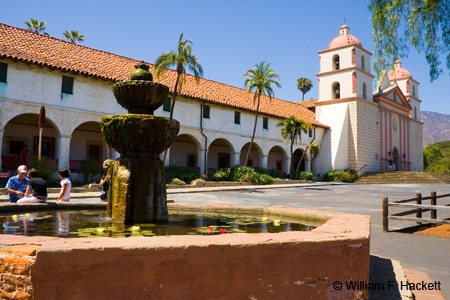Mission Santa Barbara

Mission Santa Barbara (1), “The Queen of the Missions,” is located in present-day Santa Barbara, California. The Spanish Franciscan Mission was founded on December 4, 1786, the feast day of Saint Barbara, a pagan girl who was supposedly beheaded by her father for adopting the Christian faith. Saint Barbara is known as the patron saint of artillerymen, military engineers, miners, and others who work with explosives, because of the association of her legend with lightning, and she is also the patron saint of mathematicians (who need all the help that they can get! [Just kidding!]).  The Mission was founded to evangelize a local tribe (Canaliño) of the Chumash people.
The Mission was founded to evangelize a local tribe (Canaliño) of the Chumash people.
The Mission grounds occupy a rise between the Pacific Ocean and the Santa Ynez Mountains (1) and were consecrated by Father Fermín Lasuén. Father Lasuén became president of the chain of California missions upon the death of Father Presidente Junípero Serra.
The early missionaries built three different chapels during the first few years, each larger than the previous. The construction of the current building began after the great Santa Barbara Earthquake of December 21, 1812, which destroyed the existing buildings. The reconstructed Mission was dedicated in 1820. The bell towers were damaged in the earthquake of June 29, 1925, but they were rebuilt in 1927. The appearance of the inside of the Mission has not changed significantly since 1820.
Elements of the water treatment system built by the Chumash remain, including aqueducts, two reservoirs (the larger of which was incorporated into the city’s water system), and a filter house. The original lavanderia (for washing clothes) and fountain (1, 2), with its beautiful water lilies (1, 2, 3, 4, 5, 6) remain near the entrance to the Mission.
In 1818, two Argentine ships commanded by the French privateer, Hipólito de Bouchard, threatened Santa Barbara. The padres trained about 150 neophytes to prepare for an attack. Along with Presidio soldiers, the neophytes confronted de Bouchard, who sailed away from Santa Barbara without attacking the town.
When the Mexican Congress secularized the missions in 1833, Father Presidente Narciso Durán transferred the headquarters of the California missions to Santa Barbara, which became the repository of about 3000 original documents that had been scattered among the missions. The Mission archive is the oldest library in California that remains in the hands of its founders, the Franciscans. In 1840, Alta California and Baja California were removed from the Diocese of Sonora to form the Diocese of Both Californias. Bishop Francisco García Diego y Moreno, OFM, established his cathedra at Santa Barbara. President Abraham Lincoln restored the missions to the Catholic Church in 1865.
The original City of Santa Barbara grew between the Mission proper and the harbor, specifically near El Presidio Reál de Santa Bárbara (The Royal Spanish Presidio), about a mile southeast of the Mission, and then spread throughout the coastal plain.
The weekly Catholic liturgy at the Mission is assisted by two choirs, the California Mission Schola and the Cappella Barbara. The Mission archives contain one of the richest collections of colonial Franciscan music manuscripts, many of which await examination by musical scholars.
From 1854 to 1885, the Mission was a chartered apostolic college and also functioned as a college for lay men from 1869 to 1877, which made the Mission Santa Barbara’s first institution of higher learning. Later educational initiatives eventually relocated to Berkeley to form the present-day Franciscan School of Theology.
Mission Santa Barbara functions today as a parish church and also contains a gift shop, museum, a Franciscan Friary and a retreat house. The Mission is owned by the Franciscan Province of Santa Barbara, which rents the church to the local parish.
A tour of the Mission presents the visitor with wonderful views of the courtyard (1, 2, 3, 4, 5, 6, 7) and flowers. The cemetery of the Mission is dominated by an Australian fig tree, and every turn gives fascinating views (1, 2, 3, 4, 5, 6, 7, 8, 9, 10, 11, 12, 13, 14) of California history. The door from the cemetery to the Mission chapel is marked with three “skull and crossbone” wall ornaments, on the cemetery side.
The sanctuary (1, 2) incorporates “trompe l’œil” design (note the painted “window” on the left). The rear of the church (1, 2) contains a baptismal font, a side altar, and carved wooden doors.
The exterior of the Mission presents a variety of views (1, 2, 3, 4, 5), including those of the chapel door and plaque. When we visited in July, the area in front of the chapel contained chalk artwork from the annual Madonna Festival.
I have updated my previously published index of photoblog entries for California Missions with the links for Mission Santa Inés and this entry for Mission Santa Barbara.
-Bill at Cheshire Cat Photo™
You can view higher-resolution photos (*generally* 7-30 megabytes, compressed) at the Cheshire Cat Photo™ Pro Gallery on Shutterfly™, where you can also order prints and gifts decorated with the photos of your choice from the gallery. Apparel and other gifts decorated with some of our most popular photos can be ordered from the Cheshire Cat Photo™ Store on CafePress®. Both Shutterfly™ and CafePress® ship to most international locations worldwide! If you don’t see what you want or would like to receive an email when new photos are up on the site, send us an email at info@cheshirecatphoto.com.







